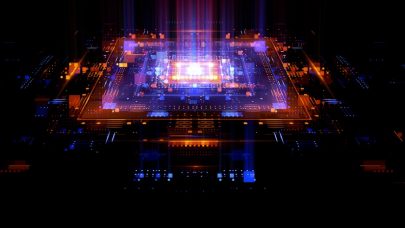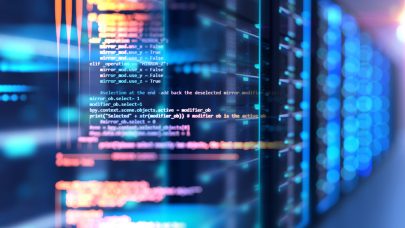The U.S. Department of Energy is leading the charge against the coronavirus pandemic in the United States by driving collaborative science toward a common goal. Further details about the DOE lab efforts, including the COVID-19 HPC Consortium (covered here), came to light this week at CERAWeek, a major energy-focused conference.
In a video presentation, Carlos Pascual (senior vice president, IHS Markit) interviews Dr. Thomas Zacharia, director of Oak Ridge National Laboratory, and Undersecretary of Energy for Science Paul Dabbar, who discuss the contributions of the National Lab complex, including how resources are being used in the context of molecular modeling, epidemiological research and the search for genomic clues.
Reviewing how the consortium was conceived with IBM, and citing some of the aligned companies who have joined (HPE, AWS, Microsoft, Nvidia, Google, and many others), Dabbar said it is the biggest tech industry alliance focused on a national emergency since World War II. “It’s very exciting to have such a broad group including a number of competitors in the private sector that normally compete against each other all coming together.”

“This truly is a consortium,” said Zacharia, “in both the private sector and the National Labs. We are 17 national laboratories that work as a system. The Department of Energy has stood up the National Virtual Biotechnology Laboratory (NVBL) that takes in all the proposals…. A sub-team is focused on utilizing the specific high performance computing resources, and this capability is made available on a priority basis to COVID-19 activities.”
In the case of Summit, the world’s top-ranked supercomputer at 149-petaflops, which Zacharia oversees, the effort offers a new level of compute capability. “There’s a group trying to ingest a billion-compound dataset,” he said, “so that they can actually look at the efficacy of these compounds for drug therapeutics development, and this is the first three-dimensional kind of calculation that they would have ever performed for something like this.
“One aspect of [the consortium] is bringing the capabilities. Equally important is the human dimension,” said Zacharia. “I’ve had a chance to talk with some of the scientists who are working on this and they say that this pandemic has actually changed how science is done. It’s become much more collaborative both internal to the laboratory, within the laboratory system, but also across agencies and industry. So it’s actually truly a testament of mobilizing the best capabilities, people, program resources and capabilities together to defeat this virus.”
Dabbar discussed the DOE’s long history of work in biology, dating back to the Manhattan Project and subsequent work on nuclear radiation damage, and then more recently the Human Genome Project that evolved out of Lawrence Livermore National Lab and was ultimately executed at the University of California Berkeley.
“The big four areas that we focus on from a broad science point of view with our various missions are materials, chemistry, physics and biology. What’s happened over the decades is that we do research on a number of different areas and we build out the capacity, and that can be switched back and forth when we build facilities.
“We were able to build off of that everyday work that we do across the complex in computing, imaging cells, working with biotech drug companies, working with researchers, and it was very natural to shift from from that broad set of capabilities, moving more under biology in the near term. Moving into biology under this public health crisis came very naturally, and we were able to do it quite quickly.”
Much of the computing power is going to a well known use case, modeling the interactions of the coronavirus’ spikey crown.
“By now almost everybody has seen the spike protease of the corona, the corona of the coronavirus,” said Zacharia, “and that is used as a particularly efficient target for looking at compounds to attach, how a chemical compound, in this case a drug, would [connect] with the protease in order to defeat this virus. And this particular study … is trying to run the analysis, screen these compounds, as to how effectively it will dock to this protease, just one of the 10 or so proteins they are looking at to see how the target will lock with the compounds in order to see what the effect is.”
Zacharia emphasized that computing is just one part of the approach. “Simultaneously, [scientists] are using the light sources and the neutron sources and the department has various laboratories to experimentally validate how these compounds actually work in real experiments so computing is driving experiments and experiments in turn is driving forward the computational capabilities to accelerate the sort of rational design of jobs.”
The DOE is also contributing to epidemiological understanding. Dabbar discusses a project out of Argonne and Fermi national labs, working with the University of Chicago, that is modeling of the virus’ spread in Chicago. The project guides policy advice on practical measures to reduce the potential spread of the virus, according to Dabbar.
Beyond the environmental, the DOE is pursuing genomic indicators of individual risk factors. “There’s the possibility of there being a specific genomic marker or sequence that might predispose someone to catching it, or having more serious impact from it,” said Dabbar. “We’re not quite certain of that, … we certainly think there’s a possibility of it. And the only way that we can do that is to collect enough patient data in terms of who’s passed away, who’s recovered, what are their environmental backgrounds, and then also collect the genomic data for enough patients — that’s a bit harder. We need to try to get a big enough universe sample of people and try to see if there’s any trends — once again coming back to the computing aspects of the department — to see if there’s a particular pattern associated with a sequence that would aim someone towards being of higher risk. We don’t know that’s necessarily the case, but we definitely have one of the research clinics to collect patient data on that to try to see if there is that would point us toward a therapy also as a possibility.”
In closing, Pascual asked about international engagement and the data collection process. Dabbar said discussions are in play with the UK, Japan and Canada, among others to assist in aggregating and analyzing data.
“We’ve been in in touch with and have interest from both the UK and Japan in particular,” Dabbar said, “either coordinating or even possibly joining the US Consortium to help do that aggregation and joint allocation of the research on a rapid basis. From a data point of view, the pulling together of patient data. The more patient data that we have, we’ll see better trends in what works and doesn’t work, and guide clinicians [to treat] individual patients. We’ve started conversations with different labs and different groups with both Canada and the UK, and hopefully we’ll be able to work with them. It takes a bit of an effort with patient data and what’s confidential and what can be aggregated versus individual and meet all the requirements. We actually have a full group working on this across the federal footprint of all the different agencies to help break down the barriers to collect that data, and we’re certainly open to other countries who are open to sharing data back and forth and trying to figure out the patterns to do the best treatment.”
Watch the full interview here: https://ceraweek.com/conversations/index.html?videoid=6154440879001

































































